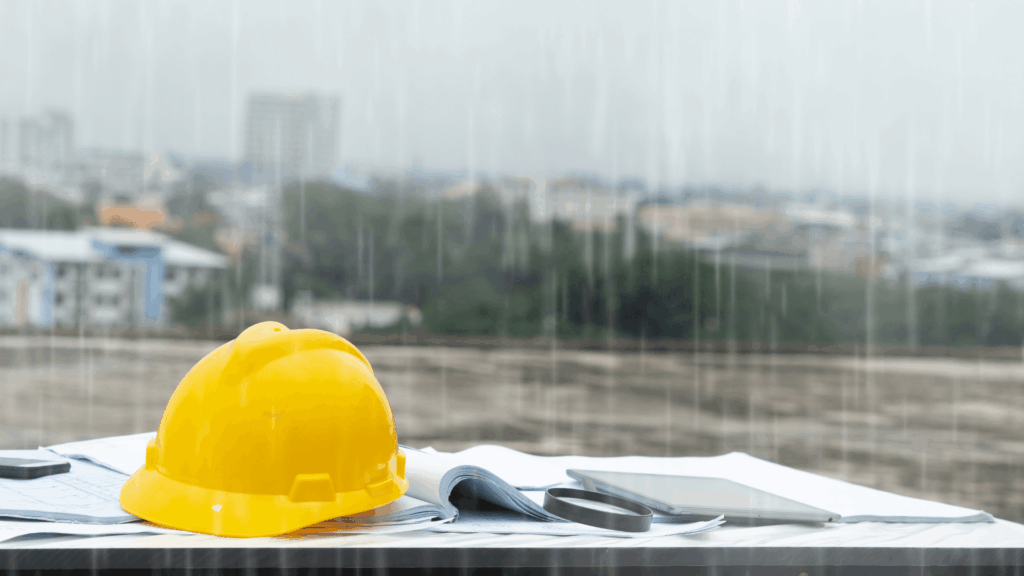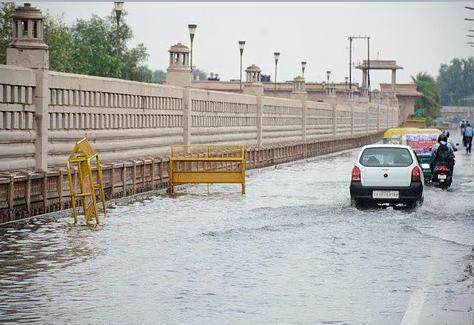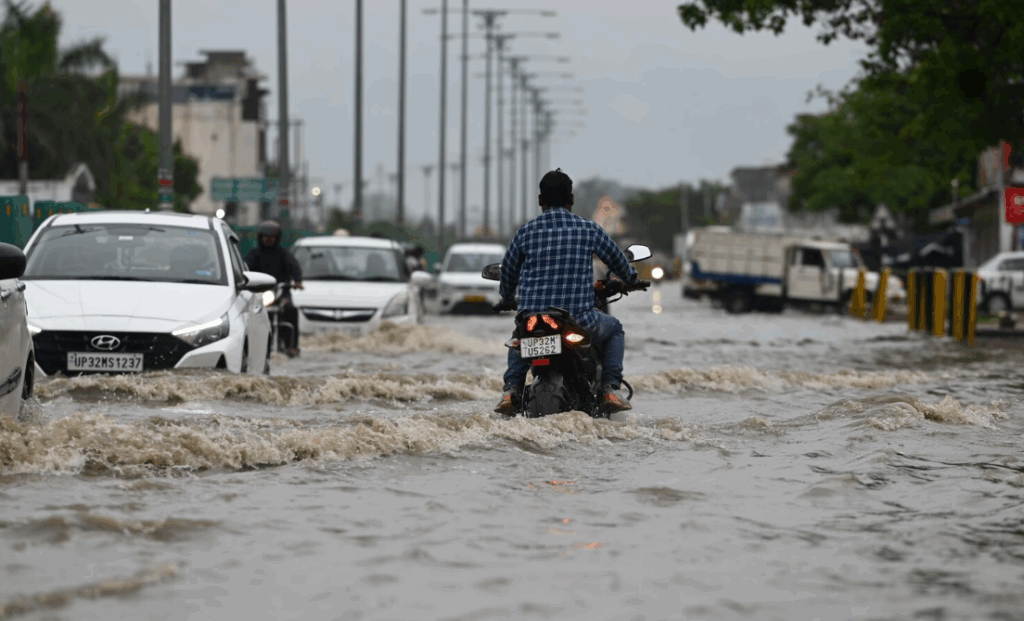Building houses and roads during the monsoon season in Lucknow creates many problems. Heavy rain from June to September makes construction work difficult.

We will help you understand some monsoon construction challenges in Lucknow with solutions. If you are a builder, house owner, or just someone interested in construction, this information will help you.
Why Monsoon Construction is Different in Lucknow?
Lucknow has special conditions that make monsoon construction more challenging than in many other cities. The city receives about 900mm of rainfall each year, with almost 80% coming during the monsoon months.
Lucknow sits on the banks of the Gomti River, which often overflows during heavy rain. The city’s soil is mostly clay and silt, which becomes very soft and slippery when wet.
Many areas in Lucknow were built long ago without modern drainage systems, so water often collects on roads and construction sites.
The city’s rapid growth in recent years means many new areas are being built without complete drainage infrastructure. All these factors together create unique challenges for builders in Lucknow during the rainy season.
Main Monsoon Problems in Lucknow
1. Water Logging
During monsoon, many areas in Lucknow face waterlogging. Areas like Indira Nagar, Gomti Nagar, and Aliganj often have water standing on roads and in construction sites. This happens because:
- Old drainage systems cannot handle heavy rain
- Construction waste blocks drains
- Low-lying areas collect water naturally
Solution: Before starting construction, make proper drainage channels around your site. Use water pumps to remove standing water. Raise the foundation level of your building higher than the road level.
2. Soil Erosion
Heavy rain washes away soil from construction sites. This is very common in new development areas like Vrindavan Yojana and Sushant Golf City. Soil erosion causes:
- Unstable foundations
- Muddy working conditions
- Loss of valuable topsoil
Solution: Cover exposed soil with plastic sheets during heavy rain. Plant grass on slopes to hold soil. Build small walls (called bunds) around your site to stop water from carrying away soil.
3. Material Damage
Construction materials like cement, bricks, and sand get damaged in the rain. This happens across all areas of Lucknow but is worse in open sites in the Kakori and Mohanlalganj areas.

Solution: Build temporary shelters with tin sheets to store materials. Keep cement bags on wooden platforms, not directly on the ground. Cover sand and aggregate (small stones) with waterproof sheets.
4. Slow Concrete Setting
Concrete takes longer to set properly during the monsoon. High humidity in areas like Charbagh and Alambagh makes this problem worse.
Solution: Add setting accelerators to the concrete mixture. These chemicals help concrete dry faster. Work during less rainy periods. Use waterproof cement for better results.
5. Foundation Problems
Digging a foundation during monsoon can be dangerous as the soil becomes soft. In old Lucknow areas like Hazratganj and Aminabad, foundation collapse is common during the rainy season.
Solution: Use sheet piling (metal sheets pushed into the ground) to support foundation walls. Remove water from foundation trenches before pouring concrete. If possible, complete foundation work before the monsoon starts.
Area-Specific Challenges and Solutions
Gomti Nagar
Problems:
- Heavy flooding near riverbank areas
- Clay soil that becomes very slippery when wet
Solutions:
- Use pile foundations that go deep into stable ground
- Install sump pumps in basements
- Build retaining walls along property boundaries facing the river
Indira Nagar
Problems:
- Underground water level rises during monsoon
- Old drainage systems often overflow
Solutions:
- Install deeper foundation with proper waterproofing
- Create recharge pits to control groundwater
- Use ready-mix concrete instead of site mixing to ensure quality

Aliganj
Problems:
- Narrow lanes make material transport difficult during rain
- Water collecting at construction sites
Solutions:
- Store materials before monsoon starts
- Use prefabricated parts that can be quickly assembled
- Install temporary roofs early in construction
Hazratganj and Old Lucknow
Problems:
- Old buildings nearby may get damaged during new construction
- Underground utilities may get exposed during digging
Solutions:
- Use less vibration-causing equipment
- Support adjacent structures with temporary supports
- Coordinate with municipal authorities before starting work
New Development Areas (Vrindavan Yojana, Sushant Golf City)
Problems:
- Undeveloped roads become muddy
- Lack of proper drainage systems
Solutions:
- Create temporary roads using brick soling (layer of bricks)
- Dig temporary drainage channels
- Use geotextile fabric to separate mud from construction area
Practical Solutions for Different Construction Stages
Site Preparation
- Check weather forecasts daily
- Clear all drainage paths before work starts
- Create sloped surfaces to direct water away from the building
- Compact the soil properly before starting the foundation

Foundation Work
- Dig and complete the foundation in phases, not all at once
- Use waterproof cement for foundation concrete
- Apply a bituminous coating on the outside of the foundation walls
- Install proper waterproofing membranes before backfilling
Wall Construction
- Use hollow blocks instead of regular bricks (they dry faster)
- Add waterproofing compounds to the mortar mixture
- Allow extra drying time between layers
- Cover freshly built walls with plastic sheets during rain
Roof Construction
- Create proper slopes on flat roofs for water drainage
- Install more water outlets than normally required
- Use waterproofing treatments before applying final finishes
- Test for leaks before monsoon arrives
Budget-Friendly Solutions for Small Builders
- Use tarpaulin sheets to create temporary work areas
- Buy cement in smaller quantities to avoid storage damage
- Raise material storage platforms using old bricks
- Create simple bamboo channels to direct water away from site
- Use local materials like burnt clay tiles that handle moisture well
Long-Term Planning Tips
- Plan the construction timeline to finish the foundation before June
- Schedule indoor work during peak monsoon months (July-August)
- Keep extra time in your schedule for rain delays
- Complete waterproofing work with proper testing before monsoon
Local Government Rules to Remember
- Get proper construction permits before starting work
- Follow Lucknow Development Authority guidelines for minimum floor height above road level
- Leave required open space around buildings for water drainage
- Do not dump construction waste in public drains (fine of Rs. 5,000-10,000)
- New buildings must have rainwater harvesting systems installed

Frequently Asked Questions
Can I do any construction work during the monsoon in Lucknow?
Yes, you can do construction during monsoon, but focus on indoor work like electrical fitting, plumbing, and interior finishing. Try to complete foundation and roof work before or after the monsoon season.
How much extra time should I add to my construction schedule because of the monsoon?
Add about 30-40% extra time to your normal schedule. For example, if something takes 10 days in normal weather, plan for 13-14 days during monsoon.
Are there special building materials I should use for monsoon construction?
Yes, use waterproof cement, rust-resistant steel, and treated wood. These materials cost a bit more but prevent bigger problems later.
How can I protect my newly constructed walls from rain damage?
Cover new walls with plastic sheets. Also, you can apply a coat of water-resistant primer before painting. Keep windows closed during heavy rain.
What should I do if water enters my construction site?
First, remove the water using pumps. Then let the area dry completely before continuing work. Check for any damage to materials or structure and fix problems before proceeding.
Is it better to pause construction during monsoon months?
For major structural work like foundations and roofing, yes. But you can continue with internal work like electrical fittings, plumbing, and flooring during these months.
How can I check if my site has proper drainage?
Pour some water or observe during light rain to see which direction the water flows. Water should move away from your building. If water collects anywhere, that area needs better drainage.
Conclusion
Building during monsoon in Lucknow is challenging but not impossible. With proper planning, the right materials, and good techniques, you can overcome most problems. The most important things to remember are:
- Plan your construction timeline around the monsoon season
- Create good drainage around your site
- Protect your materials from rain damage
- Use waterproofing at every stage of construction
- Be prepared for some delays and plan accordingly
These steps will help you complete your construction project successfully, even during the rainy season. Remember that spending a little more time and money on monsoon protection saves much more in repairs later.
